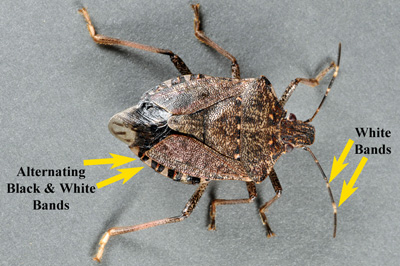An insect sample received by the Purdue Plant & Pest Diagnostic lab from a homeowner in Elkhart County on October 19, 2010 was confirmed to be the brown marmorated stink bug, Halyomorpha halys.
Since then, there have been additional confirmed finds in Tippecanoe County (Oct. 25).
These are the first confirmed records of this insect in Indiana — it has been found in Ohio this year for the first time as well and will continue expanding its range eastward.
The brown marmorated stink bug (marmorated means “having a marbled or streaked appearance”) is a native of Japan, Korea, and China and was first reported in the US in Pennsylvania in 1998.
|
|
This insect has the potential to be a pest in two ways. First, it invades houses in fall to overwinter in large aggregations, much like the dreaded multicolored Asian lady beetle.
The stink bugs will not do any damage while in/on houses, although many people find them unpleasant to look at and they do emit a strong odor when disturbed.
Stink bugs get their name because they release a pungent chemical as a defensive mechanism when threatened.
The more important concern is that the brown marmorated stink bug can become a serious crop pest. They use their sucking mouthparts to feed on a wide variety of plants found here in Indiana, including most fruit crops, a number of vegetables, corn, soybeans, and various ornamental plants.
Feeding by the brown marmorated stink bug on fruit crops causes small spots of dead tissue that can result in misshapen fruit if feeding occurs early in the season. Feeding on apples can result in pithy, pale tissue underneath the feeding wound that may turn brown and allow pathogen entry. Feeding later in the season can result in water-soaked lesions.
This pest can also feed on fruiting vegetables such as tomatoes and peppers, beans pods, and corn kernels. In some areas of the Eastern US, this stink bug has become a very serious pest.
The most effective insecticides for control are the pyrethroids such as bifenthrin, cyhalothrin, cyfluthrin, cypermethrin, etc. Most fruit crop growers prefer to avoid using these insecticides because they kill natural enemies that keep pests such as mites under control.
One fear is that if and when the brown marmorated stink bug becomes a serious pest problem, reliance on the pyrethroid insecticides for control will additional pest problems, requiring additional pesticide applications.
The adult stage of the brown marmorated stink bug has the 5-sided shield-shape common to most stink bugs. They are about 5/8 inch long and 3/8 inch wide. The upper body is mottled brown and grey with alternating light and dark bands on the edges of the abdomen.
One of the diagnostic characters for this stink bug is that the antennae have two light bands on the last two segments. Eggs are laid in clusters and are barrel-shaped and green. Nymphs are oval with yellow, brown, black and red coloration.
If experiences in states in the eastern U.S. are any indication, this pest is likely to become far more common here in Indiana over the next few years. Experiences in other parts of the country indicate that the brown marmorated stink bug will become a pest in homes before it builds up numbers to become a serious crop pest.

 Key identification characteristics, both abdominal and antennal, of the brown marmorated stink bug.
Key identification characteristics, both abdominal and antennal, of the brown marmorated stink bug.




Post a comment
Report Abusive Comment